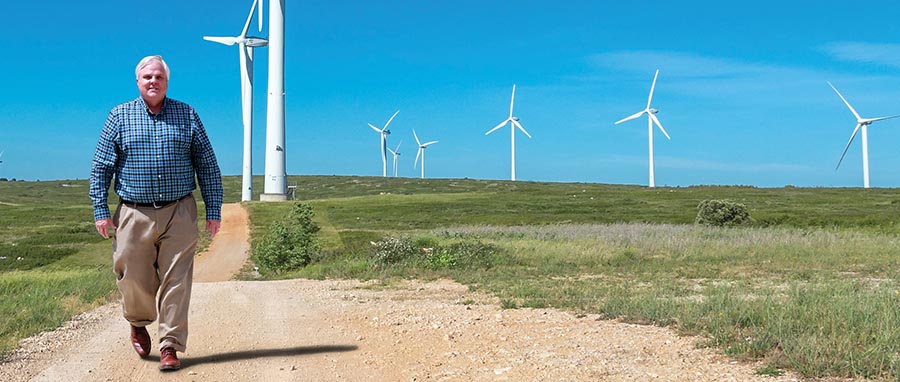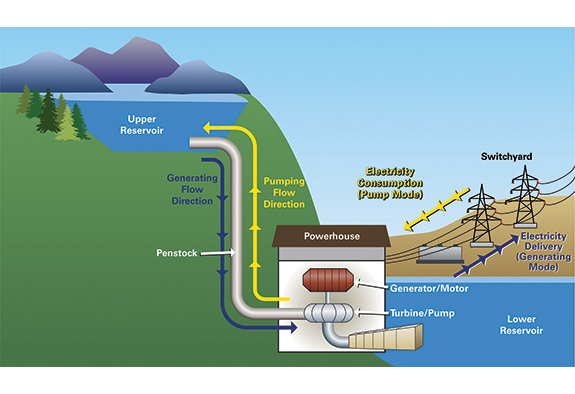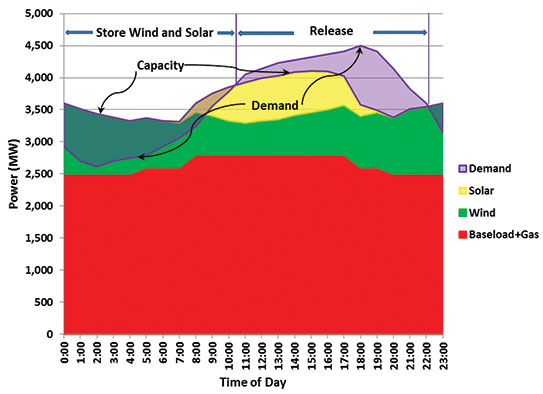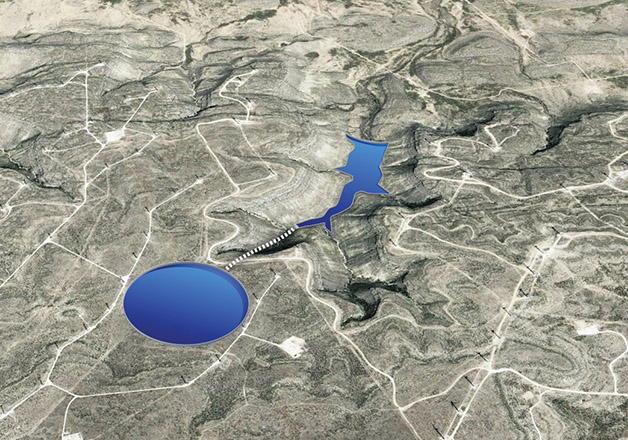What if you could store the powers of the wind and the Sun in a giant water tank?
Essentially that’s what engineers at Southwest Research Institute propose doing, looking at the feasibility of deploying pumped storage hydropower (PSH) units in West Texas. These PSH tanks are off-stream reservoirs, designed to save excess renewable energy to generate electricity — and revenue — when the wind dies down and the Sun has set.
Electric power systems use PSH for load balancing. The method uses the gravitational potential energy of water, pumped from a lower-elevation to a higher-elevation reservoir using low-cost off-peak surplus electric power to run the pumps. During periods of high electrical demand, the stored water is returned to the lower reservoir, driving turbines to produce electric power. Although the losses of the pumping process make it a net consumer of energy, the system creates value by delivering more electricity during periods of peak demand, when electricity prices are highest.

ABOUT THE AUTHOR
Dr. Gordon Wittmeyer is a hydrologist who specializes in developing and applying computational methods to solve water resource problems. He has extensive experience assembling and leading multidisciplinary teams of scientists and engineers to solve complex engineering and environmental problems associated with a range of activities, from nuclear power production to storage solutions for renewable energy.
SwRI is assessing the use of PSH units where most of Texas’ wind and solar farms are cranking out energy. Texas produces more wind power than any other state in the nation. More than 40 wind farms with a total capacity of 22,637 megawatts (MW) produced in excess of 15 percent of the electricity generated in Texas during 2017. However, Texans depend on electricity 24/7, 365 days a year, and wind and solar energy are intermittent resources. While renewable energy can be incorporated into an electric utility’s generation mix, it does not provide the on-demand energy that gas-powered peaking plants provide. Peak wind and solar production periods often occur when energy demand is low. Integrating storage systems allows utilities to capture excess energy and send it to the grid later when demand peaks.
SwRI evaluated West Texas topography to find sites that could support PSH and examined infrastructure, including transmission capacity and intermittent renewable energy sources that could benefit from PSH. Engineers also identified a new permitting process to accelerate closed-loop PSH licensing and located water supplies to fill and maintain the off-stream reservoirs. In addition, SwRI has identified some of the benefits that may be realized by entities in the power industry that deploy PSH.
Background
DETAIL
Power is the rate at which energy is generated or used. A MW is a unit of power. Energy is a measure of a system’s capacity to perform work. A MW hour (MWh) is a unit of energy.
West Texas abounds in long stretches of flat landscapes. However, the Pecos River Valley between the Edwards and Stockton Plateaus features mesas and canyons that could support multiple 10 to 1,000 MW capacity PSH units. Pairing reservoirs located on the tops of mesas with reservoirs in the canyons below could potentially store hundreds to thousands of gigawatt hours of energy from wind and solar photovoltaic (SPV) farms in the region. At present, wind generation capacity is 2,300 MW and SPV capacity is over 700 MW in the study area.
For power generation companies, PSH units located and operated with intermittent renewable energy sources can balance power generation, produce “peaking power” and provide ancillary services, such as frequency and voltage regulation.

Pumped storage hydropower uses the gravitational potential energy of water, pumped from a lower elevation to a higher elevation reservoir using low-cost surplus off-peak electric power to run the pumps. During periods of high electrical demand, the stored water is returned to the lower reservoir, driving turbines to produce electric power when demand and prices are highest.

Renewable energy sources such as wind and solar power often produce the most energy during off-peak demand hours. PSH units could store this surplus energy for release during periods of peak demand.
Traditional on-stream PSH units are subject to a long five-year permitting process by the Federal Energy Regulatory Commission (FERC). In 2019, FERC established an expedited licensing process for off-stream closed-loop PSH units that reduces the permitting process period to two years. By reducing the time needed to obtain construction permits for closed-loop PSH units, FERC is hoping to increase storage capacity and improve grid stability.
Along the Pecos River valley, numerous small, ephemeral streams have eroded softer limestone and marlstone, leaving steep-sided mesas towering 300 to 500 feet above the plains. Highly efficient, compact, closed-loop PSH units could be constructed, with upper reservoirs sited on the mesas’ flat caprocks and lower reservoirs in canyons below. Locating the power plant underground would minimize the length of the penstock, or channel for conveying water. Because the reservoirs would not be associated with environmentally sensitive perennial streams, closed-loop PSH units could be licensed under the proposed two-year FERC permitting process. SwRI has examined three potential sites where local topographic relief is sufficient for closed-loop PSH units. The stored energy could supply power for distribution across Texas via existing 345 kV transmission lines.
WEST TEXAS TOPOGRAPHY
Big Mesa is a formation on the north side of IH-10 about halfway between San Antonio and El Paso. A 160 MW wind farm is located on the eastern section of the area. The elevation of the north central section of Big Mesa is about 3,100 feet above mean sea level (amsl), while the bottom elevations of the canyon could be dammed to create a lower reservoir from 2,700 to 2,800 ft amsl. The proposed upper reservoir is 300 acres with a volume of 3,300 acre-feet (ac-ft), while the lower reservoir is 150 acres with a volume of 4,300 ac-ft. The unit could store intermittent wind energy generated during off-peak hours, releasing the energy over eight hours during peak periods.

A mesa is an elevated area of land with a flat top and steep cliffs. The characteristic formation takes its name from the Spanish word for table.
Just west of Big Mesa is Indian Mesa. Two wind farms with a capacity of 143 MW are located on the mesa, providing electricity to San Antonio and other locales. The elevation of the Indian Mesa caprock is approximately 3,000 ft amsl, while Big Harkey Canyon below has elevations ranging from 2,400 to 2,600 ft amsl. A PSH installation could include a 60-acre, 610 ac-ft upper reservoir and a 32-acre lower reservoir with a volume of 1,120 ac-ft and a water surface elevation of 2,600 ft amsl. This configuration could store surplus wind energy generated during off-peak hours to provide four hours of electricity during peak periods.
King Mountain is five miles north of McCamey, a town known as the wind energy capital of Texas. A 278 MW wind farm there generates more than 750 GWh per year (average of 2,000 MWh per day). A 1,700-acre, 24,500 ac-ft upper reservoir could be located on the caprock, which has an elevation of approximately 3,100 ft amsl. A 385-acre, 32,000 ac-ft lower reservoir could be sited in small canyons to the southwest, where elevations range from 2,550 to 2,700 ft amsl. This PSH unit could store electricity generated during off-peak hours, to release eight hours of energy during the peak demand periods.
WATER SUPPLIES
SwRI identified topography suitable for PSH units, but there remained a question of how to fill the reservoirs. The West Texas climate is semiarid, with an annual precipitation of just 13 inches. Other than the Pecos River, the region has few perennial streams. Primary tributaries to the Pecos River are Independence and Live Oak creeks, which join the Pecos 40 to 60 miles southeast of the study area. Because existing water rights on the lower Pecos River fully appropriate the annual flow and all land is privately owned, constructing infrastructure to store and divert Pecos River water to fill and maintain water levels in an off-stream, closed-loop PSH is probably not feasible.
Regional water for irrigation, livestock, industry and municipal supplies is pumped from wells in the shallow Pecos Valley or the Edwards-Trinity aquifer. The Dockum, Permian Rustler and Capitan Reef aquifers provide smaller volumes of water. However, water from these deeper aquifers is generally too saline and high in total dissolved solids for municipal and agricultural use.
Filling the Big Mesa, Indian Mesa and King Mountain reservoirs would require more than 44,000 ac-ft of water. Because the mean annual lake evaporation ranges from 63 to 71 ac-ft, the annual volume of make-up water required is more than 11,000 ac-ft. Building higher dams to shrink reservoir surface areas could decrease evaporative losses from some reservoirs.
SALINE SOLUTION
Given the limited supply of fresh water in the study area, using brackish water to fill and maintain a PSH unit may be an option. And using saltwater in a PSH unit is not unprecedented. From 1999 to 2016, Japan operated a 30 MW PSH unit in Okinawa using water pumped from the Philippine Sea into an elevated reservoir. To mitigate corrosion from seawater, its penstock was made of fiber-reinforced plastic. Other components exposed to high-velocity seawater flows were made of corrosion-resistant stainless steel. An impermeable fabric lined the reservoir to prevent seawater from seeping into the groundwater.
DETAIL
The Permian Basin spans West Texas and southeastern New Mexico and is the largest petroleum play in the United States, with more than 20 of the nation’s top-producing oil fields. Enhanced oil recovery techniques — such as hydraulic fracturing — have contributed to the success of the Permian.
News reports indicate that this PSH unit was closed and dismantled due to low rates of electricity demand in Okinawa, not technical problems. The unit operated for 17 years, long past the intended 10-year pilot study, suggesting that any corrosion was manageable.
This case study indicates that it would be technically feasible to operate a PSH unit using moderate- to high salinity water pumped from the Dockum aquifer. Hydrogeologic studies are needed to determine if the aquifer can provide the required fill and evaporation make-up water without impacting other water users. If the Dockum Aquifer cannot be used to fill and maintain the PSH reservoirs, other sources of saline water in the study area are also a possibility.

Steep-sided mesas tower 300 to 500 feet above the Pecos Valley. This could allow closed-loop PSH units to operate, siting upper reservoirs atop the mesas’ flat caprocks and lower reservoirs in the canyons below.

SwRI identified Big Mesa as a potential PSH site where an upper reservoir (circle) could be built on top of the mesa and lower reservoirs could be built into the canyons below, as illustrated on this Google Earth background image. These dual-reservoir “storage” systems could improve the availability of renewable energy by pumping and releasing water between the reservoirs to generate electricity to profitably meet demands.
PRODUCED WATER
The Permian Basin, located just north of the study area, produces vast amounts of oil — four million barrels per day in 2019. For each barrel of oil pumped in the Permian, seven barrels of high-salinity wastewater are generated, requiring recycling or disposal. In 2019, oil production activities will likely produce 10.2 billion barrels or 1.32 million ac-ft of saline wastewater. This “produced water” is often re-used in hydraulic fracturing, but even a thousand very large frac jobs would still leave 1.18 million ac-ft requiring disposal.
DETAIL
Produced water is an oil industry term describing water produced as a byproduct along with oil and gas.
The chemistry of this produced water includes brines that are saltier than seawater as well as chloride concentrations more typical of seawater. Using these latter supplies to fill and top off the reservoirs for the three proposed PSH units should work if they are modeled after the Okinawa PSH unit. If available produced water is too saline, or if the reservoir water becomes too salty from evaporation, refilling the reservoir with low- to moderate-salinity groundwater from the Dockum aquifer could manage the salinity. Because of the high evaporation rates, the salinity of reservoirs would need to be monitored and managed. This could require injecting moderate volumes of highly saline reservoir water into existing deep disposal wells.
SUMMARY
SwRI has identified topography in West Texas’ wind and solar producing region suitable for constructing PSH units with upper and lower reservoirs that could “store” four to eight hours of renewable energy. The installed capacity of intermittent renewable energy in the study area is more than 3,000 MW, and 345 kV transmission lines connect the regions to an Electric Reliability Council of Texas operated grid. With FERC’s new streamlined permitting process, much of the uncertainty associated with licensing these off-stream, closed-loop PSH units has been eliminated. While water supplies in the area are limited, SwRI identified saline water supplies available to serve the reservoirs as well as the technology needed to outfit PSH to resist corrosion.
Pumped storage hydropower could resolve one of the major challenges limiting the benefits from Texas’ solar and wind energy: timing. Peak wind and solar production often occurs when energy demand is low and drops off during peak demand. PSH can store surplus renewable energy for use when electricity demand and prices are highest.
Questions about this article? Contact Gordon Wittmeyer or call +1 210 522 5082.

